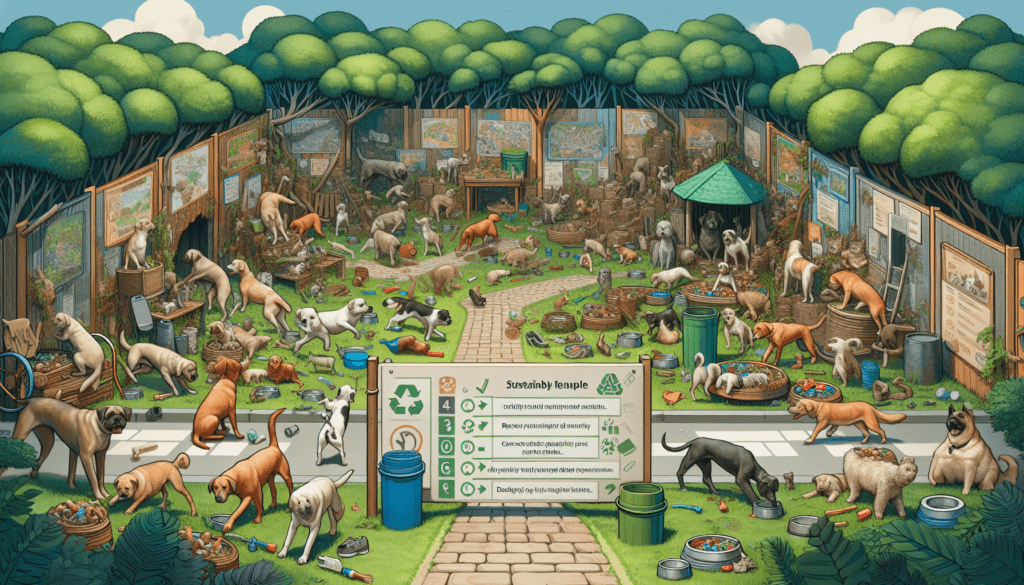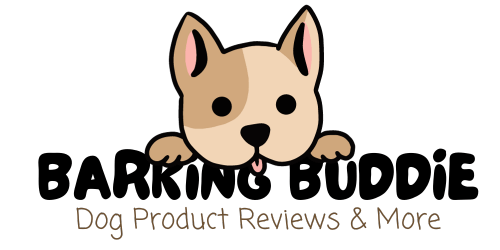In your dog community, there are countless opportunities to make a positive impact on the environment through sustainable practices. From reducing waste to encouraging eco-friendly products, there are a myriad of ways you can contribute to a greener and cleaner future for both your furry friends and the planet. In this article, we will explore some of the best ways to incorporate sustainability practices in your dog community, empowering you to take small steps towards a more environmentally conscious lifestyle. So grab your leash and let’s embark on this eco-friendly journey together!
Implementing Sustainable Waste Management
Promote Proper Waste Disposal
Promoting proper waste disposal is a crucial step towards implementing sustainable waste management in your dog community. Encourage dog owners to clean up after their pets and dispose of waste responsibly. Providing easily accessible waste bins throughout the community can help make this process more convenient and encourage responsible behavior. Additionally, educating dog owners about the environmental impact of leaving dog waste behind and the potential risks it poses to public health can create a greater sense of responsibility.
Use Biodegradable Dog Poop Bags
When it comes to waste disposal, using biodegradable dog poop bags is an eco-friendly alternative to traditional plastic bags. These bags are designed to break down naturally, reducing the environmental impact of dog waste. They are made from materials that decompose in a shorter timeframe compared to regular plastic bags, ensuring that they do not contribute to pollution in landfills or water bodies. By opting for biodegradable dog poop bags, you can actively minimize the environmental footprint of your dog community.
Set Up Recycling Stations
Setting up recycling stations within your dog community can encourage proper waste management and contribute to sustainable practices. These stations can be strategically placed in easily accessible areas, such as dog parks or common gathering spots. Make sure the recycling stations have clearly labeled bins for different types of materials, such as plastic, paper, and aluminum. Providing educational signage and instructions on what can and cannot be recycled can also help dog owners understand the importance of recycling and facilitate their participation in the process.
Support Local and Sustainable Dog Food Brands
Choose Organic and Locally Sourced Dog Food
Supporting local and sustainable dog food brands is a great way to promote sustainability in your dog community. Opt for dog food options that use organic and locally sourced ingredients. Organic dog food is made with ingredients that are grown without the use of synthetic pesticides or fertilizers, reducing the environmental impact of conventional farming practices. Locally sourced ingredients also minimize the carbon footprint associated with long-distance transportation. By choosing organic and locally sourced dog food, you are prioritizing the health of your pets and supporting sustainable agricultural practices.
Opt for Sustainable Packaging
When selecting dog food brands, consider their packaging materials. Look for options that use sustainable packaging, such as recyclable or biodegradable materials. Avoid single-use plastics or excess packaging that can contribute to waste. Packaging made from recycled materials further reduces the demand for new resources. By opting for dog food brands with sustainable packaging, you are not only being environmentally conscious but also sending a message to manufacturers and encouraging them to adopt more sustainable practices.

Encouraging Sustainable Transportation
Promote Walking and Biking
Promoting walking and biking as primary modes of transportation in your dog community can have numerous benefits for both the environment and the well-being of pets and their owners. Encourage dog owners to walk or bike to nearby parks, shopping centers, or recreational areas instead of relying on cars. Walking or biking not only reduces greenhouse gas emissions but also promotes physical exercise and healthier lifestyles for both pets and their owners. Consider creating designated walking or biking paths within your dog community to prioritize these sustainable modes of transportation.
Arrange Carpools for Dog Owners
Another way to encourage sustainable transportation within your dog community is by arranging carpools for dog owners. Many dog owners may need to travel longer distances to access certain dog-friendly facilities, such as hiking trails or training centers. By coordinating carpools, you can facilitate shared transportation, reducing the number of individual cars on the road and decreasing carbon emissions. Establish a system where dog owners can connect with each other and arrange shared rides to these destinations, making sustainable transportation more convenient and accessible for everyone.
Collaborate with Local Transportation Services
Collaborating with local transportation services, such as public buses or taxis, can further support sustainable transportation in your dog community. Advocate for pet-friendly policies and encourage these services to accommodate dogs and their owners. This can make it easier for dog owners to use public transportation options instead of relying on private cars. Working together with local transportation services can create a more inclusive and sustainable transportation network within your community.
Creating Community Gardens and Green Spaces
Establish Dog-Friendly Community Gardens
Establishing dog-friendly community gardens is a fantastic way to bring the dog community together while promoting sustainability. Designate specific areas in the gardens where dogs are allowed, ensuring they are safe and well-maintained for both humans and their four-legged companions. Encourage dog owners to actively participate in gardening activities and educate them about sustainable gardening practices. Community gardens provide opportunities for dog owners to grow their own fruits, vegetables, or herbs, reducing the need for store-bought produce and supporting sustainable food sources.
Plant Native and Beneficial Flora
Choosing native plants when landscaping or establishing green spaces in your dog community is essential for promoting biodiversity and supporting local ecosystems. Native plants are adapted to the local climate and require less water, fertilizer, and pest control, reducing the need for artificial inputs. Additionally, native plants provide habitat and food sources for local wildlife, creating a harmonious environment. Incorporate flowering plants that are beneficial to pollinators, such as bees and butterflies, to further enhance the ecological value of your green spaces.
Create Green Spaces for Dogs to Play
Designating specific green spaces for dogs to play is crucial for their physical exercise and mental stimulation. These spaces can be equipped with play structures, obstacles, and interactive elements that promote active play for dogs of all sizes and abilities. To ensure sustainability, make sure the materials used for these play areas are environmentally friendly, such as recycled plastic or sustainably sourced wood. Consider incorporating shade structures and water features to provide comfort for both dogs and their owners during hot weather. Creating sustainable and inviting green spaces for dogs encourages responsible ownership and fosters a sense of community.

Organizing Eco-Friendly Events and Activities
Host Sustainable Dog Walks and Runs
Organizing sustainable dog walks and runs is a great way to bring the dog community together while promoting eco-friendly practices. When planning these events, prioritize sustainability by encouraging participants to bring their own reusable water bottles and waste bags. Provide water stations with refillable containers instead of single-use plastic bottles. Select routes that showcase the natural beauty of your surroundings and avoid sensitive ecological areas. By hosting sustainable dog walks and runs, you can demonstrate the importance of environmental conservation and inspire others to adopt greener habits.
Arrange Educational Workshops on Sustainability
Educational workshops on sustainability serve as valuable tools for raising awareness and fostering a deeper understanding of environmental issues within your dog community. Invite knowledgeable speakers or experts to conduct workshops on various topics such as waste reduction, energy conservation, and sustainable living. Encourage participants to actively engage in discussions and provide practical tips on how to incorporate sustainable practices into their daily lives. By offering these educational workshops, you empower dog owners with the information they need to make more eco-conscious choices and contribute to a more sustainable future.
Organize Recycling and Upcycling Events
Organizing recycling and upcycling events can encourage dog owners in your community to actively participate in waste reduction efforts. Create designated collection points for items such as old dog toys, grooming tools, or accessories that can be repurposed or recycled. Collaborate with local recycling facilities or organizations that specialize in upcycling to ensure these items are processed correctly. Additionally, host workshops or demonstrations on upcycling, showcasing creative ways to transform everyday items into new and useful products. By organizing these events, you promote resourcefulness and encourage a circular approach to waste management in your dog community.
Promoting Eco-Friendly Dog Products
Use Sustainable Dog Toys and Accessories
Promoting the use of sustainable dog toys and accessories is essential for reducing the environmental impact of pet ownership. Choose toys made from natural and eco-friendly materials, such as organic cotton or natural rubber, instead of plastic. Look for durable options that can withstand rigorous play and avoid toys with batteries or electronic components that can contribute to electronic waste. When selecting accessories like leashes, collars, or pet beds, opt for products that are made from sustainable materials and produced using eco-friendly manufacturing processes.
Choose Eco-Friendly Dog Grooming Products
When grooming your dog, choose eco-friendly grooming products that minimize the use of harsh chemicals and artificial ingredients. Look for shampoos, conditioners, and grooming sprays that are made from natural, biodegradable ingredients. Avoid products that contain sulfates, parabens, or synthetic fragrances, as these can be harmful to the environment and your pet’s health. Additionally, consider using grooming tools made from sustainable materials, such as bamboo or recycled plastic. By prioritizing eco-friendly grooming products, you can ensure the well-being of your dog while minimizing your ecological footprint.
Support Sustainable Dog Bedding and Clothing
Supporting sustainable dog bedding and clothing brands is another way to incorporate sustainability into your dog community. Look for bedding made from organic and renewable materials, such as hemp or bamboo, which are grown without the use of harmful pesticides or synthetic fertilizers. Avoid bedding made from synthetic materials or treated with flame retardants, as these can be harmful to both your pet and the environment. When it comes to dog clothing, prioritize items made from organic cotton or recycled materials. By supporting sustainable brands, you show a commitment to responsible consumer choices and inspire others to do the same.

Implementing Energy Conservation Practices
Encourage the Use of Energy-Efficient Dog Facilities
Encouraging the use of energy-efficient dog facilities can significantly reduce energy consumption within your community. Consider installing energy-efficient lighting systems, such as LED bulbs, in communal areas such as dog parks, walking paths, and grooming facilities. These bulbs have a longer lifespan and use less energy than traditional incandescent or fluorescent bulbs. Additionally, equip dog facilities with motion sensors and timers to ensure that lights are only activated when needed. By implementing these energy-saving practices, you not only reduce your environmental impact but also save on energy costs.
Opt for Renewable Energy Sources
Transitioning to renewable energy sources is a major step towards a more sustainable dog community. Explore options to install solar panels or wind turbines in common areas or dog facilities to generate clean and renewable energy. This can help offset the carbon emissions associated with electricity consumption and reduce reliance on fossil fuels. Consider partnering with local renewable energy providers or reaching out to government incentives and grants to make this transition more feasible. By opting for renewable energy sources, you contribute to a greener future and inspire others to embrace sustainable energy solutions.
Promote Energy-Saving Practices in Dog Community Spaces
Promoting energy-saving practices in dog community spaces can make a significant difference in reducing energy consumption. Encourage participants to turn off lights and appliances when not in use, such as grooming tools or water fountains. Display reminders and educational materials that highlight the importance of energy conservation. Additionally, consider implementing energy-efficient technologies, such as automatic water dispensers that reduce water waste or timers for heating or cooling systems. By promoting energy-saving practices, you create a culture of sustainability within your dog community and help conserve valuable resources.
Educating Dog Owners on Sustainable Practices
Provide Resources on Sustainable Dog Care
Providing resources on sustainable dog care is essential for educating dog owners on best practices and encouraging them to make environmentally conscious choices. Create informative pamphlets or online materials that cover topics such as sustainable dog food options, waste management, and eco-friendly grooming practices. Share tips on reducing the ecological footprint of pet ownership, such as using natural remedies for common health issues or making homemade dog treats. By equipping dog owners with knowledge and resources, you empower them to make sustainable choices that benefit both their pets and the environment.
Offer Eco-Friendly Training and Behavior Techniques
Integrating eco-friendly training and behavior techniques into dog training programs can significantly contribute to sustainability efforts. Teach dog owners training methods that focus on positive reinforcement and gentle techniques, minimizing the use of punishment or harmful training tools. Encourage behaviors such as on-leash walking, obedience, and proper waste disposal during training sessions. Additionally, educate dog owners about the importance of socializing their pets to prevent anxiety-related behavioral issues and promote a healthier and more harmonious community. By offering eco-friendly training and behavior techniques, you foster responsible dog ownership and encourage sustainable interactions within your dog community.
Encourage Eco-Conscious Pet Adoption
Promoting eco-conscious pet adoption is an impactful way to encourage sustainable practices within your dog community. Collaborate with local animal shelters or rescue organizations to raise awareness about the benefits of adopting pets instead of purchasing them from breeders. Emphasize the environmental benefits of adoption, such as reducing the demand for commercial breeding facilities. Educate prospective pet owners about the importance of responsible pet ownership, including spaying/neutering, vaccination, and regular veterinary care. By encouraging eco-conscious pet adoption, you not only save lives but also promote a more sustainable approach to pet ownership.

Collaborating with Local Environmental Organizations
Forge Partnerships with Environmental Nonprofits
Forge partnerships with local environmental nonprofits to leverage their expertise and resources in implementing sustainable practices within your dog community. Collaborate with organizations that specialize in waste management, renewable energy, or environmental education to identify areas where your community can make a significant impact. Work together to develop initiatives, share knowledge, and support each other’s goals. By forging partnerships with environmental nonprofits, you can tap into a network of like-minded individuals and organizations dedicated to creating a greener and more sustainable future.
Participate in Clean-up and Restoration Projects
Participating in clean-up and restoration projects is a proactive way to contribute to local environmental causes. Organize community clean-up events where dog owners and their pets can join forces to remove litter and restore natural habitats within your dog community. Collaborate with local conservation authorities or environmental organizations to identify areas in need of restoration or protection. Engage in activities such as tree planting, habitat restoration, or shoreline clean-ups. By actively participating in these projects, you demonstrate your commitment to preserving the environment and encourage others to do the same.
Support Campaigns for Local Environmental Causes
Supporting campaigns for local environmental causes amplifies your efforts to promote sustainability in your dog community. Stay informed about ongoing campaigns or initiatives in your area and provide support through donations, volunteering, or spreading awareness. Campaigns may focus on issues such as climate change, conservation of natural resources, or protection of wildlife habitats. By aligning your dog community with these campaigns, you demonstrate your commitment to broader environmental goals and contribute to a more sustainable future.
Advocating for Dog-Friendly Green Legislation
Work with Local Authorities to Establish Dog-Friendly Green Areas
Advocating for dog-friendly green areas is essential for creating inclusive and sustainable spaces within your community. Engage with local authorities, such as city councils or park departments, and advocate for the establishment of designated dog parks, green spaces, or nature trails. Highlight the benefits of such areas, including increased physical activity for both pets and owners, improved mental well-being, and a stronger sense of community. Emphasize the importance of sustainable features, such as waste disposal stations, recycling bins, and native vegetation. By working with local authorities, you can help shape green legislation that supports both dogs’ welfare and environmental conservation.
Support Legislation for Sustainable Dog Parks and Beaches
Supporting legislation for sustainable dog parks and beaches is crucial for preserving these natural areas while providing recreational opportunities for dogs and their owners. Advocate for regulations that promote responsible pet ownership, including waste management and leash policies. Encourage the implementation of green infrastructure in these areas, such as solar-powered lighting or rain gardens to manage stormwater runoff. Promote the preservation of natural habitats within dog parks and beaches to support local biodiversity. By supporting legislation for sustainable dog parks and beaches, you can ensure the long-term protection of these valuable spaces while promoting environmentally conscious dog ownership.
Advocate for Green Building Standards in Dog Community Spaces
Advocating for green building standards in dog community spaces can help create environmentally friendly and sustainable facilities. Collaborate with local authorities and construction professionals to encourage the adoption of green building practices in dog parks, grooming facilities, or training centers. Advocate for the use of sustainable materials, energy-efficient designs, and water-saving features in the construction or renovation of these spaces. Promote the integration of renewable energy sources, such as solar panels or geothermal systems. By advocating for green building standards, you set a precedent for sustainable construction and inspire others to follow suit in their own projects.
Incorporating sustainability practices into your dog community requires a multifaceted approach encompassing waste management, transportation, green spaces, events, products, energy conservation, education, collaboration, and legislation. By following the strategies outlined in this comprehensive article, you can create a truly sustainable dog community that promotes responsible pet ownership, minimizes environmental impact, and inspires others to embrace eco-friendly practices. Remember, every step towards sustainability, no matter how small, makes a significant difference in creating a greener and healthier future for our canine companions and the planet as a whole.



